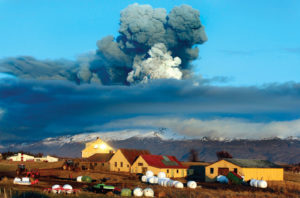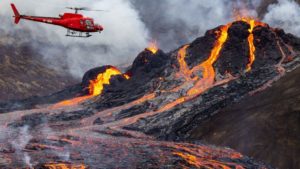
11 years on from the infamous eruption and ash cloud that shut down the European airspace, there are parallels between current travel restrictions and another Icelandic eruption that’s currently in the news.
11 years ago the now infamous eruption of Eyjafjallajökull occurred.
I remember that one, the ash cloud, right? Yes, that’s the one. The one that was all over the news, with stunning images of a huge ash plume. The one no one could pronounce on the news. The one that I still struggle to pronounce: “Hay-yah-feeah-tlah-eeaah-kuh-tl” a handy YouTube clip on Icelandic pronunciation proclaims.
“Hay-ya-feeeaahht-le…Hayyaaa-ya-feeat-le… Hay-yaaa-“. Damn now I have Hey Ya! by Outcast stuck in my head!
Pronunciation struggles aside, we all remember that fateful eruption and the ensuing ash cloud that caused havoc to travel around Europe. The likes of which, I certainly hadn’t experienced in my lifetime- that was until last year, when Coronavirus threw its hat in the ring (that’s also why there wasn’t a 10 year anniversary blog piece last year- we were all slightly preoccupied).
Iceland has plenty of volcanoes, so why did Eyjafjallajökull cause so much chaos?
Iceland is referred to as the “Land of Fire and Ice” and it is this exact combination that proved so treacherous. The volcano lies beneath the Eyjafjallajökull glacier, Iceland’s sixth largest glacier. The volcano first erupted on March 20th 2010, from an ice-free vent. It was the first time it erupted since 1821. Another fissure started erupting on 14th April from beneath the glacier. It was the interaction between the ice and magma that resulted in the plume of ash that rocketed into the atmosphere.

The Ash cloud billowing out of Eyjafjallajökull in southern Iceland, April 16th 2020 (Source: Encylopedia Britanica, Brynjar Gauti/AP).
What sort of eruption causes ash like that?
Eyjafjallajökull is classed as a phreatomagmatic eruption (or phreatic eruption). These result from the interaction of water and hot magma, causing the water to vaporize, generating an explosive steam and ash dominated eruption. In the case of Eyjafjallajökull, the heat from ongoing eruptions melted the ice from the overlying glacier. The meltwater interacted with the magma, causing rapid cooling of the magma, which resulted in the magma exploding into tiny pieces of ash. This resulted in the ash plume which shot nearly 11km into the sky.
Mass travel disruption ensued, why?
Owing to the ashy nature of the eruption, the tiny particles got caught by the wind current, which then circulated this ash around the European airspace. The prevailing winds meant that by the evening of April 15th much of the ash was already over Ireland, the UK, Scandinavia, and Germany. Fearing the effect of the ash on airplanes’ engines there was mass flight grounding and a lot of European countries closed their airspaces. Which saw lots of Easter holidaymakers trapped.
I myself was one such holidaymaker stuck in the French Alps trying to make it back to Ireland in time for school. My return journey involved planes, trains, automobiles, boats & buses! A two and a half hour plane ride to Dublin was replaced with a two day odyssey. The first leg of the journey was a 10 hour drive to Brussels, and an overnight there. The next morning we hopped on Eurostar from Brussels to London, we spent the day in London (which naturally involved a trip to the Natural History Museum!) and that evening we hopped on bus to Holyhead, in Wales, and from there we got on the overnight ferry arriving into Dublin in the early hours of the next morning.
Ironically 10 years later history repeated itself. I was stuck once again trying to scramble back to Dublin from France before the coronavirus lockdown. I’ll have to remember this if I plan any holidays in March-April 2030!
How does Eyjafjallajökull compare to the volcano that is currently erupting in Iceland?
Our newsfeeds have recently been abuzz with amazing images of illuminous lava spewing from the vent of a volcano south-west of Reykjavik in Iceland. Lava started erupting from Mount Fagradalsfjall on the evening of Friday 19th March, following a period of heightened seismic activity. It was the first time in over 800 years that the volcano erupted.

Mount Fagradalsfjall erupting for the first time in over 800 years. (Source: BBC News, Getty Images)
The Fagradalsfjall differs from Eyjafjallajökull in eruptive style, it isn’t as explosive; it is an effusive eruption. Speaking in the BBC Inside Science podcast Icelandic volcanologist Dr. Evgenia Ilyinskaya (@EIlyinskaya) compared the eruptions and their associated risks. Volcanoes like Eyjafjallajökull have eruptions that “essentially are big explosions and magma comes out and is exploded into tiny little pieces of ash”, the ash being the root of the problem in this case. In the case of Fagradalsfjall “This eruption isn’t exploding; it’s mostly pouring out lava…we’re getting loads of gases (like Sulphur dioxides) up in the air which do not necessarily have immediate impacts on aviation, but they maybe impacting people’s health because they are quite toxic…”. On Monday 5th April, hikers were evacuated from the eruption site due to a new fissure which opened up close to the hiking trail.
Not wanting to jinx anything, but for the 20th Anniversary of the Eyjafjallajökull eruption, I recommend that if you’re booking an Easter holiday, consider a staycation. If you do plan on going abroad, I’d recommend going to Iceland, because there’s a chance you’ll catch a different volcanic eruption. Just remember your camera!

Pingback: The Tonga Volcano Eruption: One Of The Largest And Most Powerful Eruptions In Recent History – Wovo.org